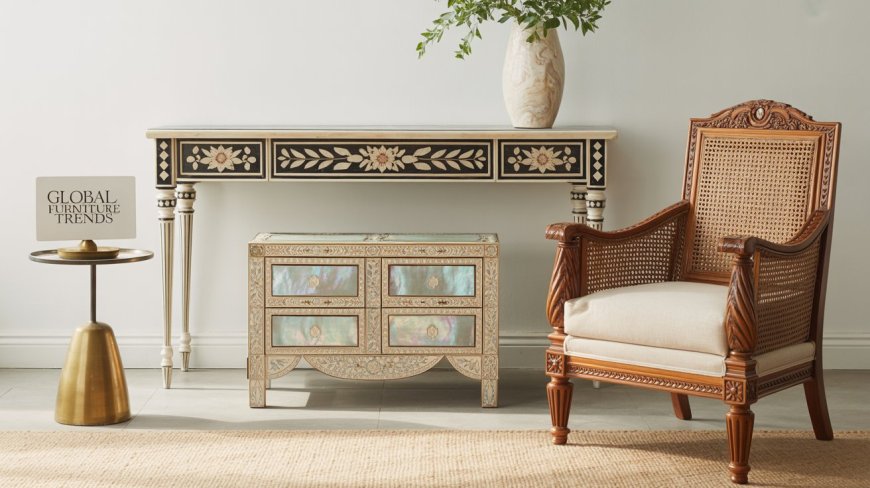What Are the Most Popular Furniture Styles Around the World?
Discover the most popular furniture styles around the world, from Scandinavian minimalism to Indian bone inlay and Middle Eastern inlay traditions. Explore global design influences, cultural heritage, and handcrafted artistry to inspire your home décor.

Furniture is not just practical - its about spirit, heritage, and the narrative of our designs. Cultures around the world have forged different unique styles historically based on local materials, historical tradition, and culture. For example, Scandinavian minimalism used for ceremonial purposes with simple lines down to ostentatious Indian inlay; each territory has defined its own comfort and beauty.
The most Popular furniture styles in the world, according to viewers, contained bone inlay, mother of pearl inlay, ornate carved detail, and finishes of brass and silver: furniture with centuries-old indicating traditions.
Scandinavian Simplicity: Minimalist, Functional, Timeless
Scandinavia is closely associated with minimalism in design. The style emerged in the early 20th century but achieved great popularity on the world stage in the post-war world, in which many were seeking affordable, democratic and well-designed objects.
This style involves several notable features:
-
Light-colored woods (birch, oak)
-
Clean lines, little ornamentation
-
Function and ergonomic design
-
Coziness and warmth (wool throws, soft lighting)
There is more to Scandinavian furniture than colourful IKEA flat packs-there are also very well-made Scandinavian makers that focus on natural materials and joinery. These pieces show that handcrafted furniture styles can be clean and modern, but still be warm and genuine.
Wabi-Sabi in Japan: The Flawed Beautiful
Japanese furniture is an expression of wabi-sabi, an aesthetic that is bound up in concepts of imperfection and impermanence. Japanese furniture is also very low-think of tatami mats and chabudai-or composed of local timber, like cedar or cypress.
In Japan, knots, cracks, and grain are accepted and highlighted as part of what nature has imposed and inscribed; rather than ignoring them, the Japanese appreciate them. Such thinking is in parallel with some sustainable design trends developing in different parts of the world. In retrospect, it prepares contemporary designers to begin to accept joinery traditions and craftsmanship that have been practiced for centuries without hinges, screws, or nails, but based on interlocking wood.
French Fashion: Provincial and Parisian Luxury.
France has two distinctly different, equally popular styles:
-
French Provincial: Rustic yet refined. Smooth curves, subtle carving, and distressed finishes-the farmhouse style. A lot of pieces are purposefully distressed so that they appear as if they have always been there.
-
Parisian Chic / Louis XVI: Luxurious upholstering with gilded accents. Ornate and symmetrical, yet welcoming. Fancy carved floral-motifs chairs upholstered in velvet and inlaid tables come to mind.
The French way of design places high value on hand-carved artistry; a task may take a craftsman several days, thus painstaking attention to scrollwork on chair legs or floral decoration on an armoire.
Indian Furniture Traditions: A Blend of Form and Colour
Indian Furniture traditions present a celebration of the senses, a foundation in craft and storytelling for centuries.
-
Bone Inlay Furniture: Founded in Rajasthan, bone inlay is a process of taking small pieces of bone and carving them by hand, then the wood is meticulously crafted around the bone pieces, creating floral and geometric patterns. One complex design could take weeks to complete, thus a unique piece emerges.
-
Mother of Pearl: Refilling the wooden base with pieces of shell that glimmer on refracted light creates patterned inlays that glow with understated luxury. Mother-of-pearl-furnishing-name convention is largely used among Indian interiors and sometimes seen with Middle Eastern ones.
-
Handcarved Furniture: From jail screens, transoms, and bedframes, handcarving is quintessentially Indian design. Handcarving tells stories through motifs of elephants, vines, and mythological stories.
-
Brass and Silver Furniture: Often found in the opulent palaces of Rajasthan, this design aesthetic has chests, tables and desks sheathed in embossed sheets of metal. Skilled artisans with great precision pound out beautiful patterns with a hammer. These pieces can be both sophisticated and rugged at the same time.
Indian Most Popular furniture styles have global appeal. Many designers today are combining traditional processes with modern forms - like a coffee table with a bone inlay top but a minimalist shape - so it can work well in an eclectic, bohemian, or even just modern home.
Middle Eastern Bespoke Furniture: Luxurious Inlay and Geometry
From Morocco to Syria, Middle Eastern furniture is stunningly functional art.
Furniture makers might use:
-
Bone inlay and mother of pearl in elaborate geometric or floral patterns
-
Dark woods like walnut or rosewood
-
Hand-carved latticework sometimes using colored glass
These products and techniques maintain centuries of tradition and are still practiced today. Workshops train many young makers on much care must be taken with tiny pieces of material being cut and shaped and inlaid to create strong graphic mosaics.
American Diversity: From Rustic to Mid-Century.
In America, furniture styles represent its great history of being a crossroads for diverse cultures and influences.
-
Rustic / Farmhouse: From cabins to new trendy farmhouses, this style embraces raw and unrefined materials - reclaimed woods, exposed joinery, and raw finishes-will focus on authenticity and durability.
-
Mid-Century Modern: striking lines with the leg taper and the novelty of materials such as molded plywood. While the style seems to want to be made by a machine and mass-produced, the originals were really made by hand in small shops.
American consumers are increasingly demanding custom and Popular furniture styles - often from local makers who are embracing slow design and natural materials.
Southeast Asian and African Traditions: Earthy and Sustainable
-
Southeast Asia: Indicated are countries like Indonesia, Malaysia, Thailand, and the Philippines for their teak and rattan furniture that is more common in Western homes. Teak is stable and resistant to the weather due to the oil in the wood. Rattan allows for incredibly detailed and sophisticated levels of weaves and make. These materials are both visually stunning and sustainable when purchased with sustainability in mind.
-
African designs: African furniture reflects rich, practical beauty from Ghanas signature carved stools to North Africas nomadic folding chairs adorned with beautiful carving and leather work. Many makers will work with native hardwoods and tools, so no two pieces are identical.
Conclusion:
Furniture from across continents and cultures tell a story of human creativeness, values and heritage. Whether it is Scandinavian design with its crisp, clean, minimalist aesthetic, American farmhouse style with its rustic appeal or the astonishing craftsmanship of bone inlay furniture, mother of pearl furniture, hand carved furniture and brass and silver furniture from India; the handcrafted traditions are still relevant and often reflect what mass produced furniture can never achieve.
Handcrafted furniture provides us with authenticity, individuality, and a connection to history and place. We are able to sustain artisans, maintain heritage skills and further develop beauty with meaning in our homes when we choose handcrafted furniture. If you want to incorporate some of this global craftsmanship in your home, companies such as Lakecity Handicrafts are maintaining these boiled traditions into their products as part of integrating craft into everyday living.





































